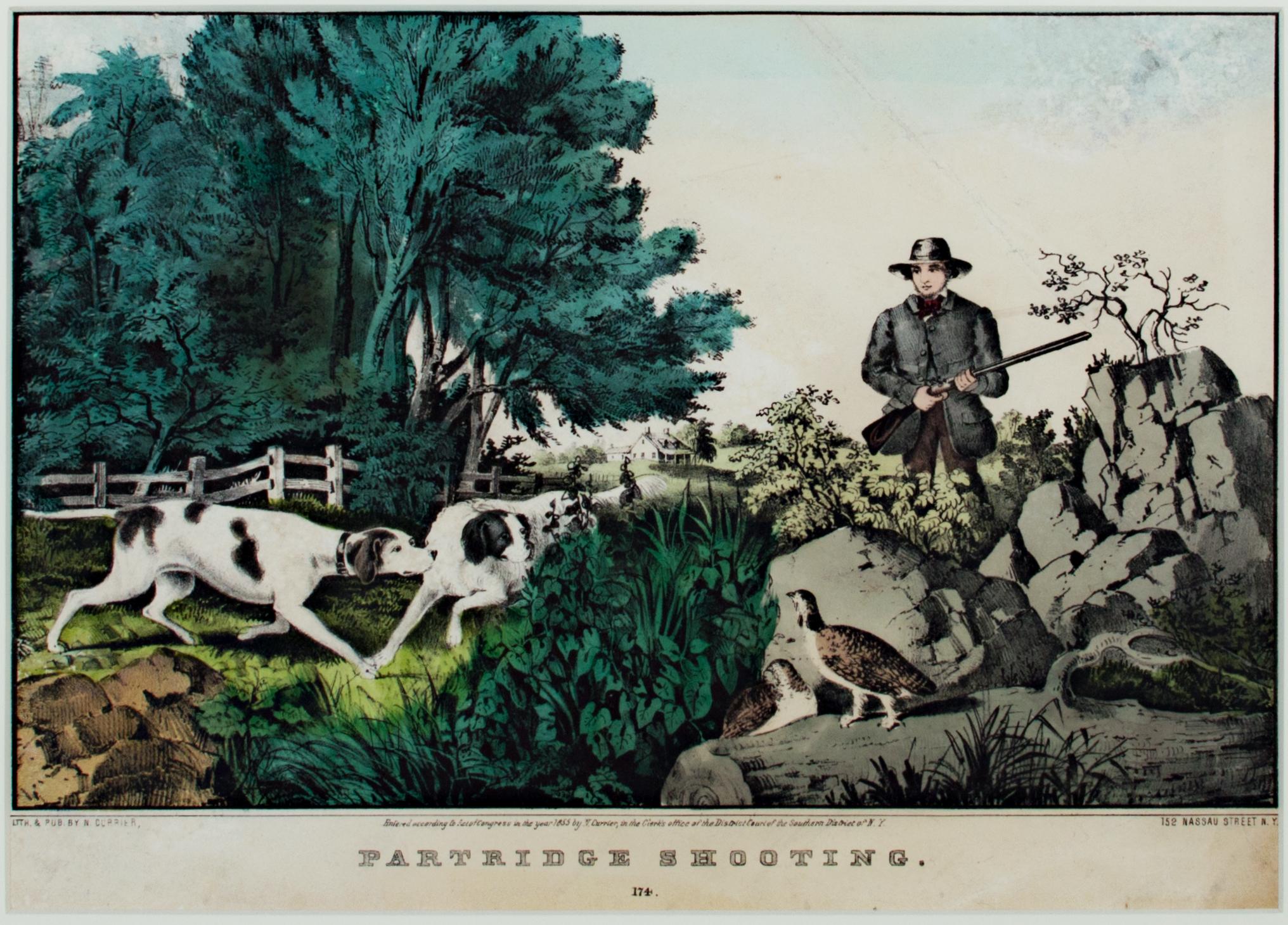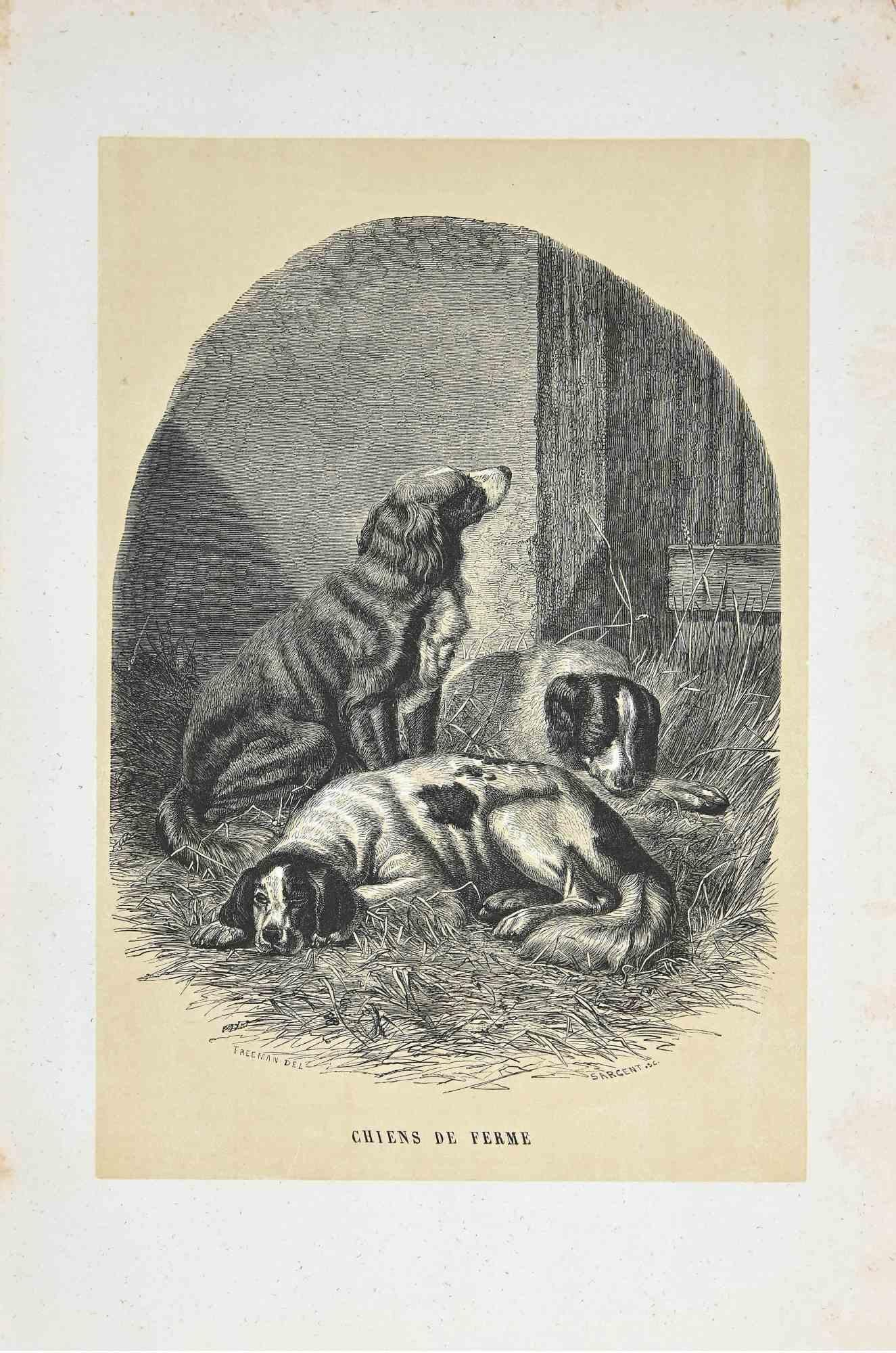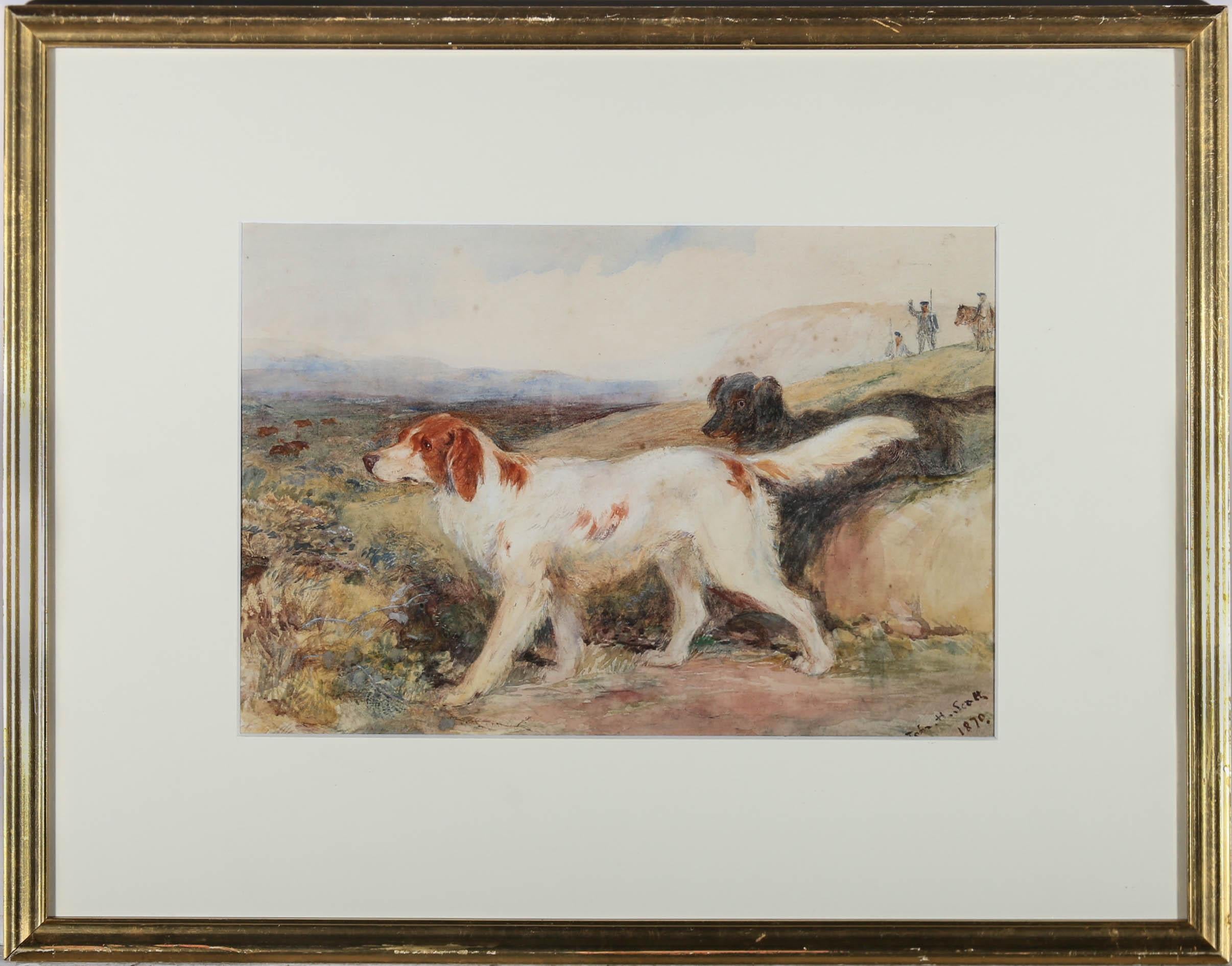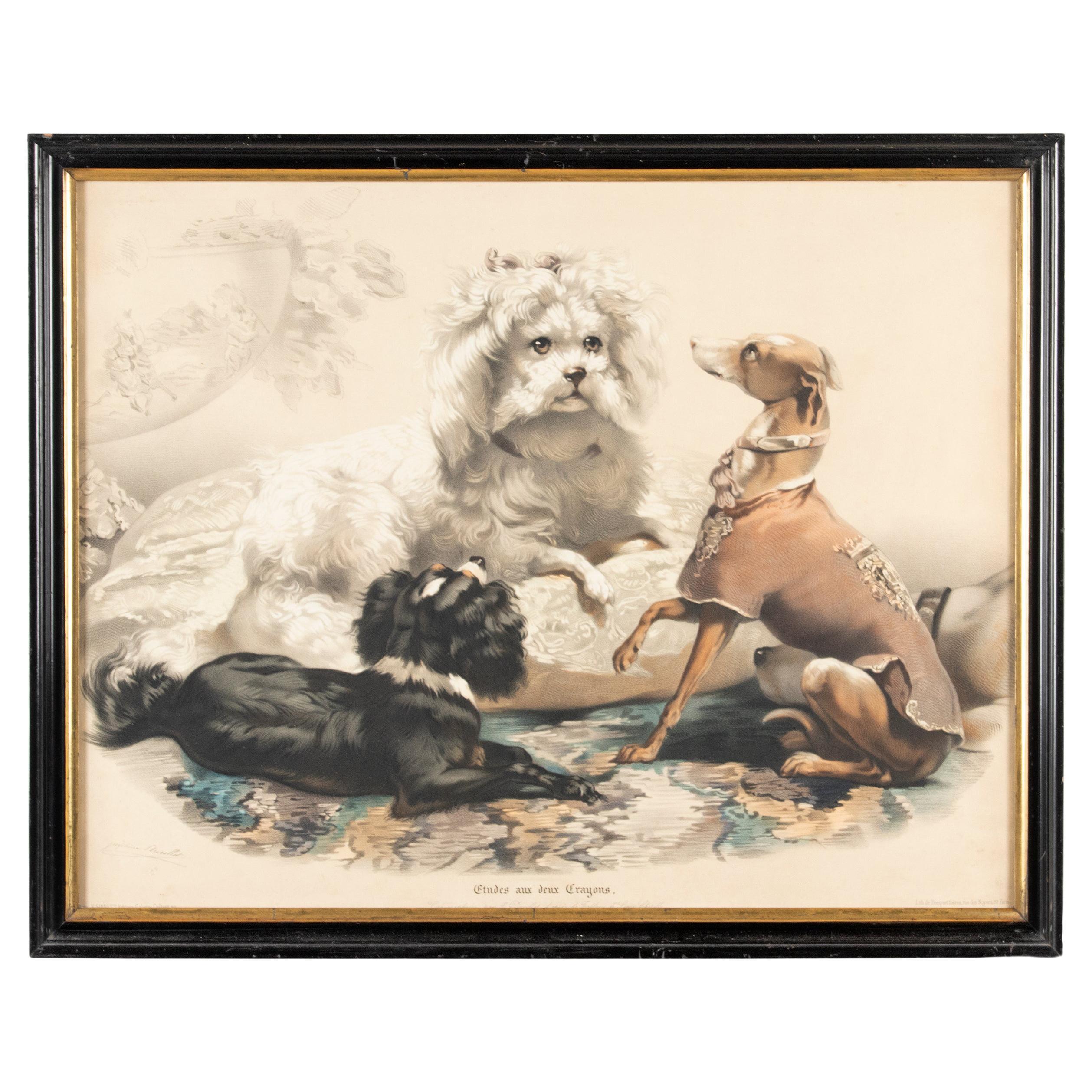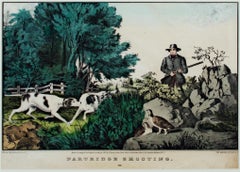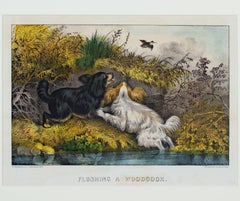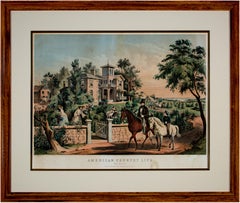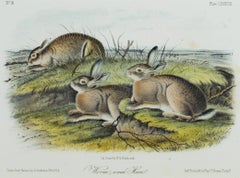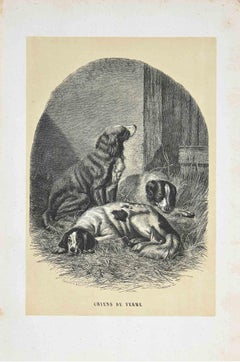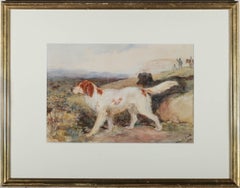Items Similar to Late 19th century color lithograph figures dog rabbit landscape cart haystacks
Want more images or videos?
Request additional images or videos from the seller
1 of 8
Jules DenneulinLate 19th century color lithograph figures dog rabbit landscape cart haystacksc. 1888
c. 1888
$2,500
£1,898.81
€2,193.75
CA$3,503.84
A$3,921.46
CHF 2,046.70
MX$47,821.55
NOK 26,194.96
SEK 24,796.88
DKK 16,371.70
Shipping
Retrieving quote...The 1stDibs Promise:
Authenticity Guarantee,
Money-Back Guarantee,
24-Hour Cancellation
About the Item
"Jamais Bredouille (Never Empty-Handed)" is a color lithograph after Jules Denneulin. It depicts a hunter showing his day's work to a farmer on a path at dusk.
20" x 26" art
40 1/4" x 45" frame
Genre Painter and Country Painter
Student of Francois Souchon and Alphonse Colas at the Ecole des Beaux-Arts de Lille. He participated in the Salon de Paris in 1865 and obtained his third medal in 1875.
Nearly all of his genre scenes have been photographically reproduced or reproduced as engravings.
- Creator:Jules Denneulin (1834 - 1904, French)
- Creation Year:c. 1888
- Dimensions:Height: 40.25 in (102.24 cm)Width: 45 in (114.3 cm)
- Medium:
- Movement & Style:
- Period:
- Condition:
- Gallery Location:Milwaukee, WI
- Reference Number:Seller: 8742g1stDibs: LU60533142843
About the Seller
4.9
Platinum Seller
Premium sellers with a 4.7+ rating and 24-hour response times
Established in 1966
1stDibs seller since 2017
434 sales on 1stDibs
Typical response time: 2 hours
- ShippingRetrieving quote...Shipping from: Milwaukee, WI
- Return Policy
Authenticity Guarantee
In the unlikely event there’s an issue with an item’s authenticity, contact us within 1 year for a full refund. DetailsMoney-Back Guarantee
If your item is not as described, is damaged in transit, or does not arrive, contact us within 7 days for a full refund. Details24-Hour Cancellation
You have a 24-hour grace period in which to reconsider your purchase, with no questions asked.Vetted Professional Sellers
Our world-class sellers must adhere to strict standards for service and quality, maintaining the integrity of our listings.Price-Match Guarantee
If you find that a seller listed the same item for a lower price elsewhere, we’ll match it.Trusted Global Delivery
Our best-in-class carrier network provides specialized shipping options worldwide, including custom delivery.More From This Seller
View All19th century color lithograph watercolor landscape figurative animal print
By Nathaniel Currier
Located in Milwaukee, WI
The present hand-colored lithograph presents the viewer with a hunting scene in a picturesque landscape. In the foreground, a man approaches two partridges as his two pointers prepare to flush them out. Beyond, a white fence draws our eyes to the homestead in the distance. Images like this one show how people in the United States were trying to identify themselves as a new nation in the North American landscape - as separate from their European counterparts but with similar similar and specific wildlife and magesties of nature. It also identifies hunting in this landscape as an American pastime.
9.25 x 12.5 inches, artwork
18.38 x 22 inches, frame
Entitled bottom center "Partridge Shooting...
Category
Mid-19th Century Romantic Figurative Prints
Materials
Watercolor, Lithograph
19th century color lithograph dogs bird nature grass pastoral animals
By Currier & Ives
Located in Milwaukee, WI
"Flushing a Woodcock" is an original hand-colored lithograph published by Currier & Ives. It depicts two dogs at the edge of a pond going after a bird that has just flown into the air.
8" x 12 1/2" art
18 1/2" x 22 1/4" frame
Currier & Ives produced their prints in a building at 33 Spruce Street where they occupied the third, fourth and fifth floors. The third floor was devoted to the hand operated printing presses that were built by Nat's cousin, Cyrus Currier, at his shop Cyrus Currier & Sons in Newark, NJ. The fourth floor found the artists, lithographers and the stone grinders...
Category
1850s Animal Prints
Materials
Lithograph
19th century color lithograph landscape figures horseback house scene trees sky
By Nathaniel Currier
Located in Milwaukee, WI
The present print is one of several examples produced for Nathaniel Currier by his longtime collaborator Frances F. "Fanny" Palmer. Harry T. Peters wrote of her: "There is no more interesting and appealing character among the group of artists who worked for Currier & Ives than Fanny Palmer. In an age when women, well-bred women in particular, did not generally work for a living Fanny Palmer for years did exacting, full-time work in order to support a large and dependent family ... Her work ... had great charm, homeliness, and a conscientious attention to detail."
One of a series of four prints showing American country life in different seasons, the image presents the viewer with a picturesque view of a successful American farm. In the foreground, a gentleman rides a horse with a young boy before a respectable Italianate country house. Two women and a young girl pick flowers in the garden and several farm workers attend to their duties. Beyond are other homes and a city on the coast.
16.63 x 23.75 inches, artwork
28.13 x 33.38 inches, frame
Entitled bottom center "American Country Life - May Morning"
Signed in the stone, lower left "F.F. Palmer, Del."
Signed in the stone, lower right "Lith. by N. Currier"
Copyrighted lower center "Entered according to Act of Congress in the year 1855 by N. Currier in the Clerk's office of the Southern District of N.Y."
Inscribed bottom center "New York, Published by N. Currier 152 Nassau Street"
Framed to conservation standards using silk-lined 100 percent rag matting and Museum Glass with a gold gilded liner, all housed in a stained wood moulding.
Nathaniel Currier was a tall introspective man with a melancholy nature. He could captivate people with his piercing stare or charm them with his sparkling blue eyes. Nathaniel was born in Roxbury, Massachusetts on March 27th, 1813, the second of four children. His parents, Nathaniel and Hannah Currier, were distant cousins who lived a humble yet spartan life. When Nathaniel was eight years old, tragedy struck. Nathaniel’s father unexpectedly passed away leaving Nathaniel and his eleven-year-old brother Lorenzo to provide for the family. In addition to their mother, Nathaniel and Lorenzo had to care for six-year-old sister Elizabeth and two-year-old brother Charles. Nathaniel worked a series of odd jobs to support the family, and at fifteen, he started what would become a life-long career when he apprenticed in the Boston lithography shop of William and John Pendleton.
A Bavarian gentleman named Alois Senefelder invented lithography just 30 years prior to young Nat Currier’s apprenticeship. While under the employ of the brothers Pendleton, Nat was taught the art of lithography by the firm’s chief printer, a French national named Dubois, who brought the lithography trade to America.
Lithography involves grinding a piece of limestone flat and smooth then drawing in mirror image on the stone with a special grease pencil. After the image is completed, the stone is etched with a solution of aqua fortis leaving the greased areas in slight relief. Water is then used to wet the stone and greased-ink is rolled onto the raised areas. Since grease and water do not mix, the greased-ink is repelled by the moisture on the stone and clings to the original grease pencil lines. The stone is then placed in a press and used as a printing block to impart black on white images to paper.
In 1833, now twenty-years old and an accomplished lithographer, Nat Currier left Boston and moved to Philadelphia to do contract work for M.E.D. Brown, a noted engraver and printer. With the promise of good money, Currier hired on to help Brown prepare lithographic stones of scientific images for the American Journal of Sciences and Arts. When Nat completed the contract work in 1834, he traveled to New York City to work once again for his mentor John Pendleton, who was now operating his own shop located at 137 Broadway. Soon after the reunion, Pendleton expressed an interest in returning to Boston and offered to sell his print shop to Currier. Young Nat did not have the financial resources to buy the shop, but being the resourceful type he found another local printer by the name of Stodart. Together they bought Pendleton’s business.
The firm ‘Currier & Stodart’ specialized in "job" printing. They produced many different types of printed items, most notably music manuscripts for local publishers. By 1835, Stodart was frustrated that the business was not making enough money and he ended the partnership, taking his investment with him. With little more than some lithographic stones, and a talent for his trade, twenty-two year old Nat Currier set up shop in a temporary office at 1 Wall Street in New York City. He named his new enterprise ‘N. Currier, Lithographer’
Nathaniel continued as a job printer and duplicated everything from music sheets to architectural plans. He experimented with portraits, disaster scenes and memorial prints, and any thing that he could sell to the public from tables in front of his shop. During 1835 he produced a disaster print Ruins of the Planter's Hotel, New Orleans, which fell at two O’clock on the Morning of the 15th of May 1835, burying 50 persons, 40 of whom Escaped with their Lives. The public had a thirst for newsworthy events, and newspapers of the day did not include pictures. By producing this print, Nat gave the public a new way to “see” the news. The print sold reasonably well, an important fact that was not lost on Currier.
Nat met and married Eliza Farnsworth in 1840. He also produced a print that same year titled Awful Conflagration of the Steamboat Lexington in Long Island Sound on Monday Evening, January 18, 1840, by which melancholy occurrence over One Hundred Persons Perished. This print sold out very quickly, and Currier was approached by an enterprising publication who contracted him to print a single sheet addition of their paper, the New York Sun. This single page paper is presumed to be the first illustrated newspaper ever published.
The success of the Lexington print launched his career nationally and put him in a position to finally lift his family up. In 1841, Nat and Eliza had their first child, a son they named Edward West Currier. That same year Nat hired his twenty-one year old brother Charles and taught him the lithography trade, he also hired his artistically inclined brother Lorenzo to travel out west and make sketches of the new frontier as material for future prints. Charles worked for the firm on and off over the years, and invented a new type of lithographic crayon which he patented and named the Crayola. Lorenzo continued selling sketches to Nat for the next few years.
In 1843, Nat and Eliza had a daughter, Eliza West Currier, but tragedy struck in early 1847 when their young daughter died from a prolonged illness. Nat and Eliza were grief stricken, and Eliza, driven by despair, gave up on life and passed away just four months after her daughter’s death.
The subject of Nat Currier’s artwork changed following the death of his wife and daughter, and he produced many memorial prints and sentimental prints during the late 1840s. The memorial prints generally depicted grief stricken families posed by gravestones (the stones were left blank so the purchasers could fill in the names of the dearly departed). The sentimental prints usually depicted idealized portraits of women and children, titled with popular Christian names of the day.
Late in 1847, Nat Currier married Lura Ormsbee, a friend of the family. Lura was a self-sufficient woman, and she immediately set out to help Nat raise six-year-old Edward and get their house in order. In 1849, Lura delivered a son, Walter Black Currier, but fate dealt them a blow when young Walter died one year later. While Nat and Lura were grieving the loss of their new son, word came from San Francisco that Nat’s brother Lorenzo had also passed away from a brief illness. Nat sank deeper into his natural quiet melancholy. Friends stopped by to console the couple, and Lura began to set an extra place at their table for these unexpected guests. She continued this tradition throughout their lives.
In 1852, Charles introduced a friend, James Merritt Ives, to Nat and suggested he hire him as a bookkeeper. Jim Ives was a native New Yorker born in 1824 and raised on the grounds of Bellevue Hospital where his father was employed as superintendent. Jim was a self-trained artist and professional bookkeeper. He was also a plump and jovial man, presenting the exact opposite image of his new boss.
Jim Ives met Charles Currier through Caroline Clark, the object of Jim’s affection. Caroline’s sister Elizabeth was married to Charles, and Caroline was a close friend of the Currier family. Jim eventually proposed marriage to Caroline and solicited an introduction to Nat Currier, through Charles, in hopes of securing a more stable income to support his future wife.
Ives quickly set out to improve and modernize his new employer’s bookkeeping methods. He reorganized the firm’s sizable inventory, and used his artistic skills to streamline the firm’s production methods. By 1857, Nathaniel had become so dependent on Jims’ skills and initiative that he offered him a full partnership in the firm and appointed him general manager. The two men chose the name ‘Currier & Ives’ for the new partnership, and became close friends.
Currier & Ives produced their prints in a building at 33 Spruce Street where they occupied the third, fourth and fifth floors. The third floor was devoted to the hand operated printing presses that were built by Nat's cousin, Cyrus Currier, at his shop Cyrus Currier & Sons in Newark, NJ. The fourth floor found the artists, lithographers and the stone grinders at work. The fifth floor housed the coloring department, and was one of the earliest production lines in the country. The colorists were generally immigrant girls, mostly German, who came to America with some formal artistic training. Each colorist was responsible for adding a single color to a print. As a colorist finished applying their color, the print was passed down the line to the next colorist to add their color. The colorists worked from a master print displayed above their table, which showed where the proper colors were to be placed. At the end of the table was a touch up artist who checked the prints for quality, touching-in areas that may have been missed as it passed down the line. During the Civil War, demand for prints became so great that coloring stencils were developed to speed up production.
Although most Currier & Ives prints were colored in house, some were sent out to contract artists. The rate Currier & Ives paid these artists for coloring work was one dollar per one hundred small folios (a penny a print) and one dollar per one dozen large folios. Currier & Ives also offered uncolored prints to dealers, with instructions (included on the price list) on how to 'prepare the prints for coloring.' In addition, schools could order uncolored prints from the firm’s catalogue to use in their painting classes.
Nathaniel Currier and James Merritt Ives attracted a wide circle of friends during their years in business. Some of their more famous acquaintances included Horace Greeley, Phineas T. Barnum, and the outspoken abolitionists Rev. Henry Ward, and John Greenleaf Whittier (the latter being a cousin of Mr. Currier).
Nat Currier and Jim Ives described their business as "Publishers of Cheap and Popular Pictures" and produced many categories of prints. These included Disaster Scenes, Sentimental Images, Sports, Humor, Hunting Scenes, Politics, Religion, City and Rural Scenes, Trains, Ships, Fire Fighters, Famous Race Horses, Historical Portraits, and just about any other topic that satisfied the general public's taste. In all, the firm produced in excess of 7500 different titles, totaling over one million prints produced from 1835 to 1907.
Nat Currier retired in 1880, and signed over his share of the firm to his son Edward. Nat died eight years later at his summer home 'Lion’s Gate' in Amesbury, Massachusetts. Jim Ives remained active in the firm until his death in 1895, when his share of the firm passed to his eldest son, Chauncey.
In 1902, faced will failing health from the ravages of Tuberculosis, Edward Currier sold his share of the firm to Chauncey Ives...
Category
Mid-19th Century Romantic Figurative Prints
Materials
Watercolor, Lithograph
19th century color lithograph hare landscape grass animal print wildlife
By John James Audubon
Located in Milwaukee, WI
"Worm-Wood Hare" is an original color lithograph by John James Audubon. It depicts three brown rabbits in a landscape. No. 18, Plate LXXXVIII, On Stone by W.E. Hitchcock.
6" x 8" ar...
Category
1840s Other Art Style Animal Prints
Materials
Lithograph
19th century color lithograph rhinoceros trees nature forest animals signed
By Louis Prang
Located in Milwaukee, WI
"Rhinoceros" is an original color chromolithograph by Louis Prang. It depicts two rhinos in a lush jungle forest.
7 1/2" x 5" art
12 1/2" x 9 1/4" paper
18 3/8" x 15 1/2" frame
Lo...
Category
1880s Animal Prints
Materials
Lithograph
19th century color lithograph horses chariot figures dynamic landscape
By Currier & Ives
Located in Milwaukee, WI
"Fast Trotting in the West (Milwaukee Race)" is an original hand-colored lithograph published by Currier & Ives. It depicts two horses pulling racing carts. The text below the picture reads "Fast Trotting in the West...Lucy and Goldsmith Maid...trotting their closely contested race over the cold spring course Milwaukee, Wis. Sept. 6th 1871...Where Goldsmith Maid won the 2nd heat in 2:17!! The fastest Mile heat in harness on record. Purse $4000 $2500 to 1st $1500 to 2nd horse____ 8 in. in harness. TIME 2:20 1/2 2:17 2:20"
16 3/4" x 26" image
22" x 27 3/4" paper
35 3/4" x 41 7/8" frame
Currier & Ives produced their prints in a building at 33 Spruce Street where they occupied the third, fourth and fifth floors. The third floor was devoted to the hand operated printing presses that were built by Nat's cousin, Cyrus Currier, at his shop Cyrus Currier & Sons in Newark, NJ. The fourth floor found the artists, lithographers and the stone grinders...
Category
1870s Animal Prints
Materials
Lithograph
You May Also Like
Farm Dogs - Original Lithograph by Paul Gervais - 1854
By Paul Gervais
Located in Roma, IT
Farm Dogs is an original lithograph on ivory-colored paper, realized by Paul Gervais (1816-1879). The artwork is from The Series of "Les Trois Règnes de la Nature", and was published...
Category
1850s Modern Figurative Prints
Materials
Lithograph
A Shepherd with his Sheeps - Original Lithograph - Late 19th Century
Located in Roma, IT
Image dimensions: 14,4 x 21,6 cm.
A Shepherd with his Sheeps is a beautiful color lithograph realized in the late 19th century.
Original Title: Der Haideschäferl.
Under the illust...
Category
Late 19th Century Animal Prints
Materials
Lithograph
John Henderson Scott - Framed Mid 19th Century Watercolour, Dog & Grouse
Located in Corsham, GB
A particularly fine 19th century watercolour by John H. Scott (1829-1886), depicting two inquisitive setters retrieving grouse in the glorious moors of Scotland. Signed and dated to ...
Category
Mid-19th Century Landscape Drawings and Watercolors
Materials
Watercolor
"French c1895 Colour Plate Depicting Two Hunting Dogs w/ Ducks On A Skiff"
Located in Bristol, CT
Art Sz: 5 1/4" x 6 1/4"
Frame Sz: 13 1/4 x 16 1/8"
Printed in Paris by Boussod, Valadon & Co.
Category
19th Century Prints and Multiples
Materials
Lithograph
Late 19th Century Lithograph with Dogs, Joséphine Ducollet
Located in Casteren, Noord-Brabant
A fine lithograph in colors of four dogs, title "Études aux deux crayons". The lithograph design is by Joséphine Ducollet. Printed by Becquet Frères, around ...
Category
Late 20th Century French Romantic Prints
Materials
Fruitwood, Paper
A Hunter with his Dogs
Located in St. Albans, GB
Gaston Le Sargeant De MONNECOVE
Oil on Canvas
Picture Size : 18 x 24" (46 x 61cm)
Outside Frame Size: 26 x 32" (66 x 81cm)
A classic example of De Monnecove's work capturing French hunting art...
Category
1890s French School Landscape Paintings
Materials
Oil
More Ways To Browse
Antique Color Lithograph
Antique Dog Prints
Antique Hand Carts
Antique Hand Trolley
Hunter And Dog
Antique Rabbit Print
Rabbit Engraving
Harem Carpet
Iron Lung
Jaguar Skin
Jiang Tie Feng
John Kuhn Glass
Jorge Tamayo
Jose Maria David
Le Carmen Des Carmen
Leroy Neiman Etchings
Marc Chagall Fleurs
Marie Therese Picasso Lithograph
